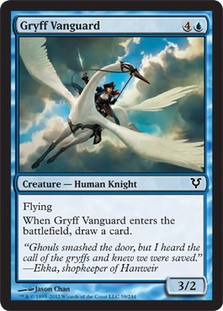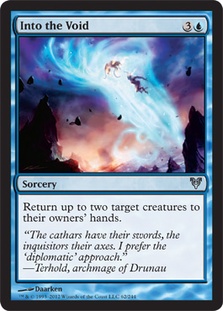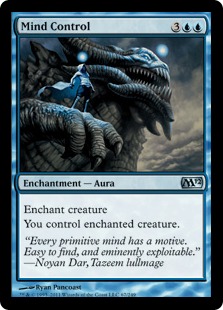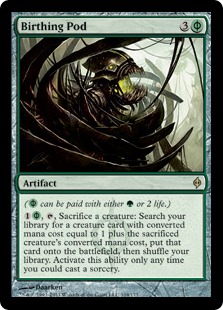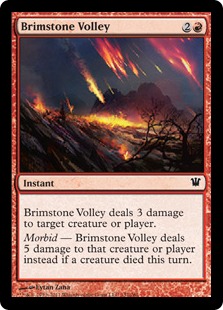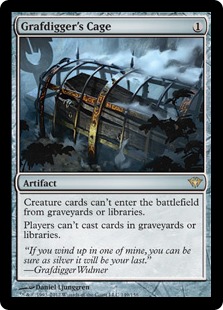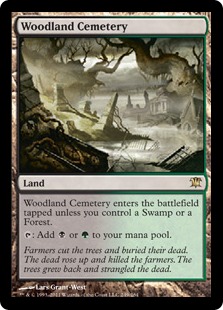Does Wolf Run Ramp with three Cavern of Souls beat Delver?
How many Blood Artists should Zombies play?
Which do you take: Volcanic Geyser or Switcheroo?
These questions all have the same answer. In fact, most questions have the same answer.
It depends.
It depends on the number of Whipflares and Slagstorms you run, if they draw Mana Leak for your Green Sun’s Zenith, if a Delver flips early, how many Plummets you have in your sideboard. It depends on the Zombies list, red or blue or Birthing Pod or no, the expected metagame, whether you’re aggro enough to want Porcelain Legionnaire instead. It depends on the colors you’ve taken, splashability, if you have cheap creatures, if you’re weak to bombs, if you’re aggressive and want a finisher.
You’re probably shaking your head right now. “This is one of the most useless articles I’ve ever read,” you’re declaring. “You’re not even answering the questions you yourself posed. All you’re telling me is what I already know—stuff depends on other stuff, blah blah. Great. You go on with your cerebral mumbo jumbo. I’m going back to surfing for pictures of Reid Duke naked.”
But wait.
(For one thing, I already checked Google images, and there’s not so much as a swimsuit photo.)
Stop to think about that sentence. Stuff depends on other stuff.
It might be more profound than you realise. Let’s follow through its consequences.
- The inherent worth/power of a card/deck is dependent on outside factors. The other cards available in the metagame. The other cards you’re playing in your deck or have in your draft pile. The decks that exist and how popular given cards/strategies are.
- As such, the inherent worth/power provides only a very rough guide as to how good a particular card/deck will be under any given circumstances.
- Therefore, decisions regarding card and deck quality—most decisions you’ll have to wrestle with over the course of building and playing a deck—are context dependent.
- There are no absolutely correct decisions within Magic. The correctness of decisions resides on a spectrum and can only be evaluated within context.
- Context changes all the time. Therefore, knowledge must constantly be reevaluated. Conclusions you’ve drawn one year don’t remain valid the next.
- The only thing stable is instability. The only thing certain is uncertainty.
Hopefully by now, you’ve paused with your finger over the “turn safe search off” button. “Well, that’s interesting, I guess,” you concede. “But I still think your theories are too head-in-the-clouds and airy-fairy for their own good. Pontificating is great and all, but is any of this really relevant? I’d learn a lot more if you wrote an article about how many Sign in Bloods to play in Zombies, preferably minus the awful Giraffe puns.”
Well, I have two responses to this. First, I’ll have you know that my puns are gravely baller, and it’s a Magic slip not to want more t’ applaud.
Secondly, while I don’t know how many people this article will reach, I do know this: to properly appreciate the role of uncertainty in Magic is easily worth a perfect Zombies seventy-five. A hundred times over.
Partly because a 7500-card Zombies list is not worth an awful lot. But it’s also incredibly important to understand how much Magic is affected by uncertainty, context, and change. Because it’s not just affected—everythingin Magic is uncertainty, context, and change. Even the question, “How much is an average decision affected by context?” is affected by context. It depends, this time on the decision.
Some decisions are affected hardly at all. Almost regardless of the deck or matchup, you’re going to want to play a land on turn 1. In contrast, the decision, “Do I want to Force of Will this Dark Ritual?” is affected very strongly by context. If you don’t Force, can they follow it up with a Tendrils for lethal? How many cards do they have in hand? Mana available? Do you know the matchup? Are they likely to play a card it’s more important to Force, such as Infernal Tutor or Yawgmoth’s Will?
Then you have decisions in the middle that are a little context dependent but not too much. For example, if you want to counter their three-drop on turn 3. Most of the time, the answer will be yes, but it varies from, “Very strongly yes,” (it’s a Dungrove Elder against your U/B Control deck) to, “No, not really,” (it’s a Sword of War and Peace, and you have both pressure and a removal spell for their next dude.)
The Answer Is Exactly 42
Sometimes, when I’m writing articles illustrating concepts, I struggle a little bit to think of good examples.
This is not one of those articles.
Every a vaguely interesting decision has depth. So much depth. This is what I love about Magic. For this article, I can pick examples at random.
Here’s one: what’s the pick? Gryff Vanguard or Into the Void?
First, we need to have some concept of inherent power. Gryff Vanguard is perhaps a little higher on power level; given no other information, you’d take it say 60% of the time. So in a vacuum we would take Gryff Vanguard. This is a super rough guide, though, because what we really want to know is which 60% and which 40%. This is a close pick. It’s not like Gryff Vanguard versus Galvanic Alchemist, which is a 99% versus 1% decision: if you miss the one-percenters and always slam the Vanguard, you aren’t doing yourself a ton of damage.
At the first level, the most important consideration for which card fits our deck better is whether we’re aggro or control. A more aggressive deck can better utilize the double bounce spell, while a more controlling deck with Angelic Walls, Galvanic Alchemists, and Defangs would prefer the flier. So we need some broad idea of the direction our deck is heading.
The second level down involves specific cards. It’s never completely clear, midway through a draft, whether you’re “aggro” or “control.” Most Limited decks are somewhere in the middle. The Galvanic Alchemists and Spectral Prisons give weight to the Gryff Vanguard, while the Mist Ravens and Primal Forcemages encourage Into the Void.
This level also involves looking for specific combos. Here, both Into the Void and Gryff Vanguard are straightforward and don’t have a lot of interesting synergy going on. You should look to see if you have a lot of other five-drops, which would push you slightly towards the Into the Void. Or you should check for redundancy in your bounce spells—if you have an Into the Void and multiple Mist Ravens, you would lean more towards Gryff Vanguard. With more synergistic picks, it’s more interesting. If, for example, you were deciding between Peel from Reality and Alchemist’s Apprentice, you would need to weigh in how many Mist Ravens and Timberland Guides you have. They incline towards making like a potato and Peeling.
Then we get into the subtle levels that people often forget exist. What’s your color combination? Draft experience is important here. If you’ve drafted a lot of Avacyn Restored, you’ll be aware that U/G decks are generally tempo based. As such, if your first two picks are Primal Forcemage and Wandering Wolf, you’ll want to take Into the Void. Even though the particular cards in your draft pile don’t incline towards one pick over another, the cards in the overall format do. Specifically the green common ones, which are biased towards efficient creatures that synergize well with bounce.
An even more subtle level: what cards have you passed? This one affects the final decision so rarely, it’s often correct to just forget about it. Yet it is there. Suppose your first pack was very strong and contained a Peel from Reality as one of the weaker cards; there’s a chance it’ll come back ninth. In this case, you need the bounce spell less because you’re likely to have redundancy in that area.
Or for the same scenario flipped, imagine you’ve passed a Mind Control and two Talrand’s Invocations (yes, I know they aren’t in the same set; remember, this is a thought experiment). In this case, it’s likely that you will play against someone with one of these cards. Into the Void is superb against Mind Control and merely great against Talrand’s Invocation, while Gryff Vanguard holds no special appeal in either case. Knowing these cards are in the draft pushes you that extra fraction towards the sorcery.
Quantifying all this material looks roughly like this:
Gryff Vanguard
Base value: 30
Playing control: +10
For each…
Galvanic Alchemist: +3
Spectral Prison: +4
Angelic Wall: +5
Defang: +2
Generic good removal: +1
Other five-drops: -1
More expensive spells: -2
Into the Void
Base value: 20
Playing aggro: +15
For each…
Wingcrafter: +4
Scrapskin Drake: +4
Kruin Striker: +5
Primal Forcemage: +5
Peel from Reality: -4
Mist Raven: -2
Generic good removal: -1
U/G: +5
U/R: +2
Good opposing auras passed: +0.5
Obviously, don’t read anything into these numbers. They are not there as hard and fast rules; their aim is to get you to think about how you would generate your own rankings in similar scenarios.
At this point, you’re shaking your head and muttering. “This is ridiculous,” you’re saying, vexed. “How is anyone supposed to internalize this much information? And about a single pick, at that?! If you add a third choice, the layers grow by an order of complexity. You can’t be seriously suggesting I have to analyze that to become good at Magic. There has to be a simpler way.”
Well…not really. The more information you take into account, the more accurate your decisions will be. There’s no endpoint after which everyone is exactly the same and some people are just luckier than others. Owen Turtenwald is not somehow ten times as lucky as you (well, by some accounts he actually kind of is, but it’s not the point). This is why so many people are passable at Magic and so few really excellent.
That said, there’s no need to internalize a bunch of data. In fact, that totally misses the point. What you do need to do is get used to considering the many different aspects that influence a decision at high speed, starting with the most important and continuing through. This involves a lot of practice and patient reflection. Not interested? Fine, but don’t come complaining to me about how your local PTQ winner is the luckiest guy on earth.
Here’s another example. Should you play Birthing Pod or Brimstone Volley in your B/R Zombies deck?
Again, we’ll start by evaluating for baseline power. Birthing Pod is inherently a very, very good card. On an even board, Birthing Pod will take over the game given a couple turns. It puts free 4/3s on the table given Geralf’s Messenger and Phyrexian Metamorph, drains with Blood Artist, and turns Gravecrawler into free two-drops. In addition, it gives you a thousand options every turn—if Skinrender or Falkenrath Aristocrat or Zealous Conscripts wins you the game, Birthing Pod wins you the game. This is a very important dimension to evaluate along.
Brimstone Volley is not as powerful—in fact, it’s not particularly powerful at all and many red decks exclude it. But it’s synergistic. Given you’re the aggressor eight games out of ten and given it’s very easy to send creatures to the graveyard, Brimstone Volley turns many a tight race in your favor. Brimstone Volley + Bonfire of the Damned + Geralf’s Messenger + Falkenrath Aristocrat gives your deck a powerful plan A: hand out 20 damage in an awful hurry.
So: Birthing Pod 35, Brimstone Volley 20. But the cards do fundamentally different things, and to appreciate which one is better depends on the metagame. There’s a truism in Constructed that you want to be about 10% slower than your opponent. The slightly bigger deck can do slightly more powerful things, and its spells being only a little more expensive, it’s not too clunky.
This means the major determinant of which strategy is better is how quick the environment is. In a format of slower control decks, you’d rather run Brimstone Volley. As good as Birthing Pod is, it doesn’t beat multiple Titans; if that’s the strategy they’re on, you’d rather burn them out before the game gets to that stage.
In a format where the dominant deck is reasonably quick, Birthing Pod starts to look a lot more alluring. The metagame alters around that deck; you can’t play to win past turn 6 or 7 because that’s simply too slow. So Zombies adopts the grind-out-the-midgame strategy more often than the straight up kill-you-turn-6.
I’d say arbitrarily: slow metagame Brimstone Volley +10, midrange metagame Birthing Pod +15. Very fast metagame, Brimstone Volley +15 because you can’t afford to take damage from your Pods. For example, if you play Standard Zombies in Modern, you’d do well to cut Pods entirely. The only way you’ll steal a game or two is by being quick and them stumbling.
Next level. What support does each card have? With only two red/black duals, Brimstone Volley is harder to cast. It’s a deck that also expects to support Geralf’s Messenger and possibly Phyrexian Obliterator. Birthing Pod is mostly indifferent to whether green mana is available.
This is a significant drawback. -5 Brimstone Volley. Mana is a vital consideration in any Constructed deck. It doesn’t matter how great your spells are if you can’t cast them.
Here is also where we look for synergy within the deck. Guys that die easily, like Fume Spitter, Mortarpod, and Falkenrath Aristocrat, are +1.5 to Brimstone Volley per copy. Guys like Geralf’s Messenger and Blood Artist that are fantastic with sacrifice outlets are +1.5 to Birthing Pod per copy. The more reach we have, the better Brimstone Volley becomes (Falkenrath Aristocrat, Geralf’s Messenger) and the more specialized creatures are available, the better Birthing Pod is (Zealous Conscripts).
At the third level, we look for cards other people might play against us. If lots of people are running Primeval Titan out at about turn 5, Birthing Pod becomes a very tempting proposition because Zealous Conscripts on it usually ends the game. If Enduring Ideal into Form of the Dragon is a significant metagame presence, we’d want to be able to deal five at instant speed. If direct damage is a big part of the environment, Birthing Pod is worse—we take too much pain from it. Or if Frites is huge, and, as a consequence, everyone’s siding in Grafdigger’s Cage.
A corollary—I don’t know if anyone’s tried this, but you could reasonably put a Woodland Cemetery or two in a Zombies deck without Birthing Pod. Grafdigger’s Cage is pretty miserable against lists without Pod and fair to good against lists that have it. So by representing that you have Pod in your deck, if Cage is big in sideboards, you could gain more percentage points against the field than you lose from having Cemetery come into play tapped every once in a while.
Is it worth it? I don’t know. But this is the kind of reasoning you can employ once you start thinking about uncertainty. There are no definite answers, just a lot of truly fascinating questions.
And incidentally, the statement at the start is a false dichotomy. To date, as far as I know, no one has put Birthing Pod and Brimstone Volley in the same deck together. But there’s no reason why you can’t have three of one and two of the other.
No One Knows Anything
I recently went to a talk by a famous Australian entrepreneur and philanthropist. He credited his success to an unusual mental fluke. “I don’t have a problem dealing with uncertainty,” he told us. “Other people would look at my decisions and say, ‘Wait. What if this happens? What about the other thing? You’ll go bankrupt. How can you go ahead with this if you’re not sure how it’s going to turn out?’
I would just tell them the truth. I don’t know, and I’m ok with that. You have to be. There’s no way of being sure. You work hard, look at everything you know, and do the best you can.”
…
How do I know everything in this article isn’t wrong?
Simple.
I don’t.
Until next time,
Jeremy

